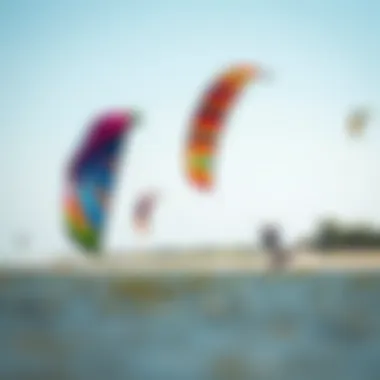Navigate Richmond's Tides for Ultimate Kiteboarding


Intro
Kiteboarding in Richmond offers not just a thrilling experience on the water but also a deeper connection to nature’s rhythms. Understanding the tides is essential for enthusiasts wanting to maximize their time on the water while ensuring safety. This guide dives into the intricate dance between kiteboarding and tidal patterns, providing essential information for both novices and experienced riders.
Richmond's water features present unique opportunities, but they also come with their share of challenges. Geographical nuances can affect wind direction and tidal flows, influencing everything from wave height to safety considerations. Whether you're just starting your kiteboarding journey or have some experience under your belt, this information can help you harness the wind effectively and responsibly.
Not only will we explore equipment and technique in this guide, but we’ll also emphasize the community aspect of kiteboarding in Richmond. Joining local groups or engaging with fellow kiteboarders can provide shared wisdom that enhances your riding experience. After all, kiteboarding isn’t just about individual skill; it's also about connecting with the environment and the people who ride it.
Understanding Tidal Dynamics
Understanding the dynamics of tides is critical for anyone keen on kiteboarding in Richmond. The ebb and flow of water play a significant role in determining not just the conditions on the water but also the time of day when kiteboarding is most advantageous. Knowing how tides work can enhance not only the enjoyment of the sport but also the safety of the kiteboarders.
This section provides a foundation for kiteboarders to comprehend the implications of tidal movements, which can vary widely due to numerous factors, including the moon’s gravitational pull, the sun’s position, and local geographical features.
The Science of Tides
The science behind tides is rooted in gravitational forces exerted by the moon and sun. When the moon pulls on the Earth, it creates a bulge of water in the ocean, known as high tide. Conversely, areas of the ocean that are perpendicular to the moon’s gravitational pull experience low tide. Typically, this cycle occurs twice a day, with some variations depending on the location.
In Richmond, the interplay of these gravitational forces is influenced by the shape of the nearby bay and rivers, resulting in a unique tidal experience. This rhythm of high and low tides creates a symphony of conditions that kiteboarders must learn to interpret for optimal performance.
Tidal Influences in Richmond
Understanding the unique characteristics of Richmond's tides involves looking closely at two major components: geographical features and coastal proximity.
Geographical Features
The geographical features surrounding Richmond play a significant role in shaping the local tidal patterns. Richmond is situated near the confluence of several waterways, including the James River. This confluence creates a variety of wind patterns, current interactions, and tidal behaviors that can influence kiteboarding sessions.
For instance, the shallow areas created by mudflats and bays can limit water depth during low tide, making it necessary for kiteboarders to pay attention to tidal schedules to avoid struggling in unpredictable water conditions. This geographical setting also offers a dramatic backdrop, providing kiteboarders with scenic views as they harness the forces of nature.
Unique features include the local bridges and structures along the shoreline, which can affect wind flow and tidal current patterns, presenting both opportunities and challenges for riders. Understanding these geographical quirks is essential for improving performance and safety in the water.
Coastal Proximity
Richmond's proximity to the coast also influences tidal behavior and kiteboarding conditions. Being adjacent to the Chesapeake Bay means that the tidal patterns of Richmond can markedly differ from inland locations. This coastal influence means that the tidal range is often greater, and the water can change rapidly.
The beaches along the bay can provide ample space for kiteboarding enthusiasts, but they can also compound the effects of winds and tidal currents. Those venturing out should remain vigilant as this coastal closeness could lead to unforeseen challenges, such as sudden shifts in wind direction or strength.
In sum, those who kiteboard in Richmond benefit significantly from understanding these tidal influences. Harnessing this knowledge not only leads to better performance but also fosters a safer kiteboarding environment where enthusiasts can truly enjoy the thrill of the ride.
Kiteboarding in Richmond requires keen awareness of the tides. Knowledge is power—learn the tides, and you unleash the wind.
Kiteboarding and Tidal Patterns
Understanding the interplay between kiteboarding and tidal patterns is vital for anyone looking to harness the winds and waters of Richmond. Kiteboarding operates heavily on how the tides behave, which can significantly influence both the performance and safety of riders. When you combine the dynamics of water levels with wind direction, you create a complex yet exhilarating arena for kiteboarding practices. Moreover, being aware of tidal patterns helps kiteboarders plan their sessions—maximizing enjoyment while minimizing risks.
Impact of Tides on Kiteboarding
Optimal Tidal Conditions
The best conditions for kiteboarding align with specific tidal scenarios. These optimal conditions typically arise during the transitional phases of a tide—specifically, the rising or falling tides. During these times, the wind patterns often align better with the water movement, giving riders that added push to glide smoothly across the surface. This combination tends to create larger, more manageable waves and reduced currents, making for comfortable and enjoyable rides.


A key characteristic of optimal tidal conditions is the relatively stable water levels, allowing kiteboarders to confidently navigate without sudden drops or unpredictable swells. This is particularly beneficial for novice riders who may not yet have the skill set to handle choppy waters or rapid changes in tide. However, one must remember that while these conditions appear favorable, they don’t eliminate the need for precaution. Staying informed about the local tidal cycles is crucial to finding these sweet spots.
Challenging Tidal Scenarios
On the flip side, there are challenging tidal scenarios that can be quite the test for even the more seasoned kiteboarding aficionados. These conditions usually manifest during significant tidal shifts or during the peak of storm occurrences, where water levels change rapidly. Strong currents can develop, and the winds might turn unpredictable—making it imperative to have strong control and awareness.
A highlight of challenging tidal scenarios is the thrilling experience they offer. Despite the risks, many kiteboarders seek out these conditions for the adrenaline rush. With stronger currents, riders can perform advanced tricks and enjoy a unique challenge. That said, these scenarios are not for the faint-hearted. Safety considerations cannot be overstated; advanced skills and a thorough understanding of one’s equipment are necessary to successfully navigate such conditions.
Tidal Timing for Optimal Performance
Understanding Tide Tables
One of the indispensable tools for kiteboarders keen on riding Richmond’s waters is the tide table. Essentially, tide tables provide crucial information regarding the expected tide levels at various times throughout the day. Understanding these tables can significantly contribute to making informed decisions about when to hit the water.
These tables typically show high and low tide times, which can help kiteboarders identify the best moments to ride based on their ability level. Knowing when tides will be optimal reduces the risk of heading out only to find exceptionally high tides or dangerous currents. Thus, being adept at reading tide tables is a beneficial skill for anyone trying to make the most of their kiteboarding experience.
Identifying Peak Times
Identifying the peak times for kiteboarding creates an opportunity for riders to take advantage of ideal conditions for long runs and exciting tricks. Peak times generally align with the transition periods between high and low tides—particularly during the first and last hours of the tide movement. This timing provides optimal conditions due to the relative calmness of the water combined with favorable wind velocities.
Focus on experiencing these peak windows, as they often provide the sweetest rides. Essentially, this strategic approach allows kiteboarders not only to enhance their skill levels but also to gain insights into how tides can directly affect ride quality. It's all about planning ahead, finding your rhythm, and, above all, enjoying every exhilarating moment on the water.
"Kiteboarding in Richmond is not just a sport; it's a dance with the tides. Knowing the rhythm is key."
For comprehensive tidal information, you can refer to resources such as NOAA for accurate tide predictions, ensuring every kiteboarding session is well-timed and safe.
Safety Considerations in Tidal Waters
When engaging in kiteboarding in Richmond, understanding safety considerations in tidal waters is paramount. The interplay of tides, wind, and weather can create a dynamic environment that is both enticing and treacherous. Ensuring safety enhances enjoyment and fosters a culture of responsibility among kiteboarders. This section will dissect the specific risks associated with tidal conditions, appropriate safety gear, and protocols to follow in potentially hazardous situations.
Risks Associated with Tidal Conditions
Strong Currents
Strong currents can be both a friend and enemy in kiteboarding. These currents often serve to amplify the thrill of the sport, offering the opportunity for exhilarating rides. However, they can also be quite dangerous. One key characteristic of strong currents in Richmond's tidal waters is their suddenness; they can change with little warning. It’s not uncommon for a relaxed day of kiteboarding to morph into a struggle against swift water.
Why are strong currents vital to consider? Because they can easily sweep an unprepared or unsuspecting kiteboarder away from safety. Understanding the flow and strength of the currents will give you a foundational knowledge to navigate the waters effectively.
- Advantages:
- Disadvantages:
- Can provide an added challenge for experienced kiteboarders.
- Often result in vibrant surf conditions desirable for advanced maneuvers.
- Increased risk of losing control or being pulled out to deeper waters.
- Requires advanced skills to navigate safely.
Changing Water Levels
Changing water levels can create an entirely different set of challenges. Tide fluctuations influence the depth and width of navigable areas, making it crucial for kiteboarders to be cognizant of their surrounding environment. A key characteristic of changing water levels is their predictability, tied closely to established tide tables, but they can still catch even seasoned kiteboarders off guard. What might begin as a large expanse of water can quickly evaporate, leaving dangerous rocks or obstructions exposed.
Understanding these shifts helps kiteboarders plan their sessions to ensure an enjoyable experience. Knowing the habits of the tides is akin to reading the wind—essential for maximizing performance while maintaining safety.
- Advantages:
- Disadvantages:
- Predictable in nature, providing opportunities to plan ahead.
- Could lead to unique spots being revealed at lower tides.


- Can lead to sudden changes in terrain.
- May require navigating unfamiliar obstacles.
Safety Gear Recommendations
Equipping oneself with essential safety gear is as vital as understanding the local tide patterns. Good gear not only enhances performance but can also be the difference between a close call and a serious accident. Here are some recommendations:
Essential Equipment
Most importantly, essential equipment like a personal flotation device (PFD) is a no-brainer. A PFD can be a lifesaver in tumultuous waters, providing crucial buoyancy should you find yourself in a challenging situation. Other essential gear includes an adequate wetsuit—which shields against cold and prevents injuries from impacts—and a harness that fits well to enhance control and support during those high-flying maneuvers.
- Characteristics: Common equipment tends to have high durability and can withstand the rigors of both raging currents and sharp rocks.
- Benefits: Enhanced safety and comfort make for a more enjoyable experience on the water.
Emergency Protocols
Having emergency protocols in place can be the bedrock of a safe kiteboarding experience. This might include simple things like identifying safe exit points along your route or having a reliable communication device like a waterproof VHF radio. Establishing a buddy system can also greatly increase safety. When someone is taking off or landing, it's wise to have another fellow kiteboarder on the lookout for potential hazards.
- Characterstics: These protocols are often straightforward, requiring minimal additional gear.
- Benefits: Knowing exactly what to do during an emergency can minimize chaos and help maintain composure in high-stress situations.
Kiteboarding is a thrilling sport, but that thrill comes with responsibility. Understanding the risks involved and preparing effectively can ensure that safety doesn't take a back seat to adventure.
Preparing for Kiteboarding Sessions
Preparing for kiteboarding sessions is essential for all enthusiasts, whether you're a novice or an experienced rider. The right preparation not only ensures a thrilling day on the water but also contributes significantly to your safety and enjoyment. Understanding local weather patterns, evaluating equipment needs, and meticulously planning your session can be the difference between a great experience and a frustrating one.
Evaluating Weather Conditions
Wind Patterns
Wind patterns play a crucial role in kiteboarding. They determine how well you can maneuver and control your kite, which directly affects your performance on the water. In Richmond, wind conditions can vary dramatically based on the time of year. For kiteboarders, the best winds are steady and consistent, typically ranging between 12-25 knots. This sweet spot elevates your abilities while also allowing for fun tricks and jumps.
One unique feature of the Richmond area is its proximity to both the coast and inland bodies of water, which can create localized wind effects. Cross-shore winds are particularly advantageous since they allow riders to launch and land without significant risks from obstacles. However, it’s vital to be aware of gusty conditions, which can make controlling the kite challenging and potentially dangerous.
Temperature Considerations
Temperature also plays a significant part in kiteboarding. Riding in extreme heat or cold can affect your performance and comfort. Richmond experiences seasonal variances, which means that the temperature can notably influence your gear choices. Ideally, aim for sessions in mild temperatures, typically between 65°F and 85°F, which provide optimal comfort and performance.
Wearing appropriate gear can also mitigate any temperature impacts. For example, some kiteboarders may choose thin wetsuits or shorties in warmer months, whereas thicker suits are best for cooler days. However, remember that too hot conditions may tire you out quicker, while lower temps can lead to hypothermia if not appropriately addressed.
Equipment Selection Based on Tidal Conditions
Board Type
The type of board you choose can make a significant difference in your kiteboarding experience. In the contest of tidal sessions, selecting the right board that matches your skill level and the conditions is crucial. There are various board options, such as directional boards and twin-tips. Directional boards are typically more challenging to master, yet they offer superior control in choppy water and higher speeds across waves, perfect for the tides in Richmond.
On the other hand, twin-tips are popular due to their versatility. They enable easy switch riding and are often favored by beginners who are just getting their feet wet, so to speak. Consider the local tidal flow when choosing your board—strong currents may require a stiffer, faster board to keep you on top of the water, whereas mellow conditions may allow for more flexibility.
Kite Size
Kite size is another critical consideration influenced by both tidal and wind conditions. Selecting the right kite involves understanding the wind range for your specific kite and how it interacts with tidal changes. In Richmond, a medium-sized kite, often around 9 to 12 meters, is generally sufficient for most conditions.
The unique thing about kite size is that it can drastically change your experience. A larger kite will catch more wind, allowing for greater lifts but can be harder to control in higher winds. Conversely, a smaller kite might offer better handling and acceleration in windy conditions but could lack power in lighter winds. Assess the strength and consistency of the wind, along with the tide, before making a choice. Make sure you've got a good setup so that you can enjoy every moment on the water.
In summary, preparing well for your kiteboarding sessions is all about understanding the interplay of weather patterns, equipment choices, and tidal influences. By staying informed and adaptable, you can maximize both your performance and enjoyment during each outing.


Community and Local Events
The vibrant kiteboarding community in Richmond serves as a backbone for enthusiasts, offering opportunities for networking, learning, and shared experiences. Kiteboarding is often more than just a solo sport; it's a means to forge connections that can enhance skills and enrich overall enjoyment. Through local events, competitions, and clubs, kiteboarders can not only elevate their game but also build lasting friendships and camaraderie with fellow riders.
Connecting with Fellow Kiteboarders
Local Clubs and Organizations
Local clubs in Richmond play a pivotal role in nurturing the kiteboarding culture. They serve as a hub for kiteboarders of all levels, providing support and resources that anyone can tap into. One of the notable aspects of these clubs is their ability to create a welcoming environment. For newcomers, finding a club to join can be a game changer. The sense of belonging among members often fosters a spirit of mentorship, where experienced kiteboarders are willing to share tips and techniques.
Clubs often organize practice sessions, workshops, and outings which not only enhance skills but also promote safe practices. A key feature is the community learning aspect—many clubs host regular meetups where members can exchange knowledge, skills, and even gear.
However, while these organizations can be incredibly beneficial, choosing the right one requires due diligence. Not all clubs may cater to your specific skill level or interests, so it's advisable to visit a few and gauge the atmosphere before committing.
Online Forums and Resources
In today's digital age, online forums and resources have become a vital part of the kiteboarding ecosystem. They offer a platform for kiteboarders to connect irrespective of geographical constraints. Whether it's the Facebook groups dedicated to local kiteboarding or platforms like Reddit where users share insights, these virtual communities have expanded access to information and support.
A primary advantage of online resources is the vast amount of knowledge available at your fingertips. You can find gear reviews, instructional videos, and real-time weather updates, making them an indispensable tool for both rookie and veteran riders.
Yet, while online platforms allow for easy information sharing, they can also lead to misinformation if not vetted correctly. It’s crucial to cross-reference advice and experiences shared in these forums with reputable sources or club affiliations.
Participating in Local Competitions
Engaging in local competitions not only fosters a competitive spirit but also helps participants gain a deeper understanding of their own abilities. It enables kiteboarders to showcase their skills while receiving valuable feedback from judges and peers alike.
Understanding Judging Criteria
Comprehending the judging criteria in competitions can significantly influence a participant's approach. Most competitions use a scoring system focused on aspects like difficulty, execution, and style. Understanding these criteria not only helps in preparation but can also enhance performance when it counts.
Why is grasping this information essential? Because it allows participants to focus on strengths while also recognizing areas for improvement. This can ultimately contribute to overall progression in the sport. It is advisable for competitors to engage with past participants to get a clearer insight into what judges look for during evaluations.
Preparation for Events
Getting ready for a competition is as much about practice as it is about the logistics involved. Key factors like ensuring appropriate gear, understanding the competition format, and arriving early to familiarize oneself with the venue are crucial.
One unique feature of proper preparation is the mental aspect; participating in competitions requires not only physical readiness but also a sound state of mind. Taking part in pre-event workshops or seminars often hosted by local clubs can be helpful in building confidence and clarifying expectations.
Ultimately, thorough preparation enhances performance and ensures that participants not only compete but also enjoy the experience. Setting aside time for practice runs and even engaging in pre-competition social gatherings can provide a balanced approach to the competition lead-up.
Ending: Navigating the Tides of Richmond
Understanding how the tides operate in Richmond is not just about enjoying a sport; it’s about ensuring a safe and fulfilling experience while kiteboarding. The key takeaway is that optimal kiteboarding conditions hinge on a thorough understanding of local tidal dynamics, weather patterns, and personal competencies. It encourages athletes to be more attuned to their environment which ultimately results in more enjoyable outings.
The insights shared in this article are particularly vital for kiteboarders at all skill levels. For beginners, these teachings foster a foundational knowledge that enhances learning and reduces risks. More seasoned riders can refine their understanding, adjusting their kiteboarding techniques based on complex tidal influences. Engaging responsibly with these elements not only mitigates hazards but also enriches the community, making it more vibrant.
Moreover, knowledge fosters respect for the kiteboarding community and the environment. By sharing insights and experiences, kiteboarders can build valuable networks that uplift the sport, ensuring that Richmond remains a top-tier destination for both local riders and visiting enthusiasts alike.
Summarizing Key Takeaways
- Tides Matter: The interplay of tidal dynamics significantly affects kiteboarding conditions. Being aware of high and low tides is essential for safety and performance.
- Safety First: Understanding risks like strong currents and changing water levels is key to mitigating dangers while out on the water.
- Community Connection: Engaging with fellow kiteboarders through local clubs and social media platforms can enhance knowledge sharing and create a supportive network.
- Equipment Matters: Proper gear selections influenced by tidal conditions lead to better performance and safety.
Encouraging Responsible Kiteboarding Practices
To ensure the longevity of kiteboarding as a sport, practitioners must adopt responsible habits. This includes:
- Environmental Awareness: Respecting natural ecosystems helps sustain local wildlife and maintains the area’s aesthetic value.
- Safety Gear Usage: Always wear essential safety equipment such as life jackets and helmets. It’s better to have and not need than to need and not have.
- Local Regulations Adherence: Follow all local kiteboarding rules and guidelines to promote a healthy relationship with other water users.
- Educate Others: Share knowledge about tidal conditions with newcomers to the sport. This will help uplift the entire community, ensuring everyone rides safely and effectively.
In summation, navigating the tides in Richmond is an art that requires practice, respect for nature, and knowledge-sharing among community members. Kiteboarding is more than just a sport; it’s an opportunity to connect, enjoy, and appreciate the beautiful waters of Richmond.







